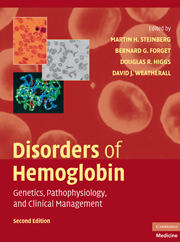Book contents
- Frontmatter
- Contents
- List of Contributors
- Foreword, by H. Franklin Bunn
- Preface
- Introduction, by David J. Weatherall
- SECTION ONE THE MOLECULAR, CELLULAR, AND GENETIC BASIS OF HEMOGLOBIN DISORDERS
- SECTION TWO PATHOPHYSIOLOGY OF HEMOGLOBIN AND ITS DISORDERS
- SECTION THREE α THALASSEMIA
- SECTION FOUR THE β THALASSEMIAS
- SECTION FIVE SICKLE CELL DISEASE
- SECTION SIX OTHER CLINICALLY IMPORTANT DISORDERS OF HEMOGLOBIN
- SECTION SEVEN SPECIAL TOPICS IN HEMOGLOBINOPATHIES
- SECTION EIGHT NEW APPROACHES TO THE TREATMENT OF HEMOGLOBINOPATHIES AND THALASSEMIA
- Index
- Plate section
SECTION SIX - OTHER CLINICALLY IMPORTANT DISORDERS OF HEMOGLOBIN
Published online by Cambridge University Press: 03 May 2010
- Frontmatter
- Contents
- List of Contributors
- Foreword, by H. Franklin Bunn
- Preface
- Introduction, by David J. Weatherall
- SECTION ONE THE MOLECULAR, CELLULAR, AND GENETIC BASIS OF HEMOGLOBIN DISORDERS
- SECTION TWO PATHOPHYSIOLOGY OF HEMOGLOBIN AND ITS DISORDERS
- SECTION THREE α THALASSEMIA
- SECTION FOUR THE β THALASSEMIAS
- SECTION FIVE SICKLE CELL DISEASE
- SECTION SIX OTHER CLINICALLY IMPORTANT DISORDERS OF HEMOGLOBIN
- SECTION SEVEN SPECIAL TOPICS IN HEMOGLOBINOPATHIES
- SECTION EIGHT NEW APPROACHES TO THE TREATMENT OF HEMOGLOBINOPATHIES AND THALASSEMIA
- Index
- Plate section
Summary
Three chapters discuss rare inherited hemoglobinopathies including unstable hemoglobins, hemoglobins with altered oxygen affinity, hemoglobins easily oxidized, and a miscellaneous group of hemoglobin variants with interesting biological properties, some of which are clinically important. Acquired disorders of hemoglobin can arise from heme iron oxidation due to inherited abnormalities of hemoglobin-reducing enzymes or because of exposure to exogenous oxidizing agents.
Rare hemoglobinopathies have taught us much about the struc24-87519-function relationships of hemoglobin. Hemoglobin mutants have provided the most comprehensive list of mutations of any system in human biology, creating a map for understanding mutation in other genetic loci. Globin gene mutations – these include nearly every class of mutation so far described – provided an early catalog of the possible mechanisms of genetic disease.
An accounting of globin gene mutations in early 2008 listed 1,326 unique mutations (http://globin.cse.psu.edu/). Here, we discuss some rare hemoglobin mutations. As comparatively few globin residues are critical for maintaining the structural integrity and functional utility of the molecule, most hemoglobin mutations are not associated with hematological or clinical abnormalities and so escape detection. Some mutations, although not medically important, illustrate interesting biological and anthropological principles.
Abnormal hemoglobins with high or low oxygen affinity, variants that have their heme iron oxidized to the ferric form causing methemoglobinemia (HbM), or hemoglobin variants that are unstable are abnormalities seen rarely by the general physician and infrequently encountered in the practice of hematology.
- Type
- Chapter
- Information
- Disorders of HemoglobinGenetics, Pathophysiology, and Clinical Management, pp. 587 - 588Publisher: Cambridge University PressPrint publication year: 2009



